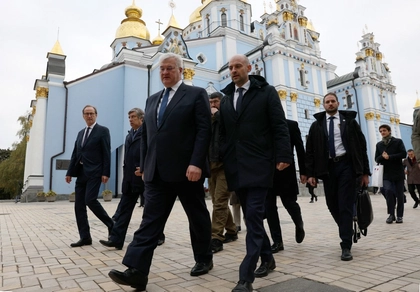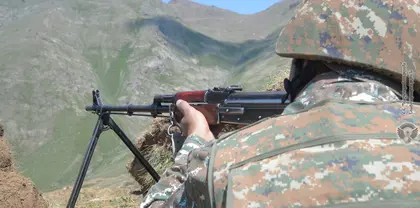A shootout along the shared border of Azerbaijan and Armenia on Tuesday, April 11, killed seven servicemen, AFP reported.
Tensions between the two longstanding rivals have flared up regularly in their decades-long territorial dispute over the territory of Nagorno-Karabakh.
JOIN US ON TELEGRAM
Follow our coverage of the war on the @Kyivpost_official.
What’s happening now?
“Armenian army positions deployed near the settlement of Dyg (at the two countries’ shared border) opened heavy fire at Azerbaijani army positions,” the Azerbaijani defense ministry in Baku said in a statement, adding that Azerbaijani troops “have returned fire.”
A few hours later, it said three servicemen were killed in the clashes.
The Armenian defense ministry reported four dead and six wounded. It blamed Baku for initiating the shootout.
“At 16:00 (1200 GMT) on Tuesday, Azerbaijani armed forces opened fire in the direction of Armenian servicemen who were conducting engineering works” near the border, the ministry said.
Remind me. What’s Nagorno-Karabakh?
Nagorno-Karabakh is an Armenian-majority enclave in southwestern Azerbaijan. The two ex-Soviet Caucasus nations have fought two wars over the mountainous region.
The first Nagorno-Karabakh War simmered at a low intensity from 1988 to 1994.
When the Soviet Union dissolved in 1991, both sides tried to lay claim to arms caches left by the Soviet army. As a result, the fighting increased, with both sides looking to control the disputed territory.

Russian Victory Would Bring 'Chaos': French FM
After six years of fighting and upwards of 20,000 deaths, both sides were exhausted. Russia helped broker a ceasefire. The Nagorno-Karabakh region remained within Azerbaijan, but with de facto independence.
However, Armenia occupied close to 20 percent of Azerbaijan’s territory and hundreds of thousands of Azeris had to flee from their homes, with many thousands of Armenians also being displaced from Azerbaijan.
The conflict remained frozen with occasional shooting for the next 26 years.
In 2020, the Second Nagorno-Karabakh War broke out. It lasted for 44 days, with nearly 7,000 deaths on both sides.
The outcome was a clear-cut Azerbaijani victory, thanks in large part to Turkish and Israeli backing with drones and other equipment. Azerbaijan was able to regain control over much of its territory under Armenian occupation.
In November 2020, Russia sent a force of about 2,000 soldiers to the region as peacekeepers, for a renewable five-year mission.
How can the Russians keep the peace if they’re busy with their own war?
That’s exactly what the Armenians have been asking.
Up to now, the Armenians have been ostensibly pro-Russian, in the hopes that Moscow can use its leverage to counter Turkish influence in Azerbaijan. But the situation is more complicated, with Moscow having supplied Baku with weapons as well.
For the moment, Russia is too busy in Ukraine to throw its weight around in the Caucasus, and the Azerbaijanis seem to be aware of that fact.
In the meantime, the Armenians, have become increasingly vocal about their disappointment with Russia.
What does this mean for the bigger picture?
With the prospect of the Russian Federation experiencing turmoil, if not outright rebellion, as its war against Ukraine goes from bad to worse, there is the distinct possibility that what’s left of Moscow’s empire will continue to fray at the edges.
In such a scenario, the Caucasus would be a powder keg. Already, Russia is occupying 20 percent of Georgian territory. Tensions are high in Dagestan and Chechnya, and many Chechens are fighting alongside Ukrainians with the intention of ultimately liberating Chechnya from the grip of Ramzan Kadyrov, whom they consider a Moscow puppet.
If the Russian Federation falls apart, then much of the mountainous region between Turkey and southern Russia – which is rife with different, often antagonistic, ethnic groups from one valley to the next – could descend into violence similar to that connected with Nagorno-Karabakh.
You can also highlight the text and press Ctrl + Enter






